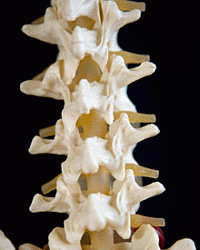A team of German, Dutch, and American researchers have found the cancer drug Taxol has properties that can help treat spinal cord injuries. The scientists reported their findings online this week in Science Express on the journal Science Web site.
Two key factors impeding the regeneration of nerve cells after a spinal cord injury are the destabilization of the cytoskeleton — a structure in the cell that acts as a muscle and skeleton — and the development of scar tissue. Destabilization of the cytoskeleton prevents regrowth of cells, while scar tissue creates a barrier for severed nerve cells.
In the central nervous system (CNS), the cytoskeleton is made up of small protein tubes called microtubules. When a CNS nerve cell is injured, the microtubules — normally arranged in an orderly fashion — become completely jumbled, which makes structured growth impossible. In addition, the lost tissue is progressively replaced by scar tissue creating a barrier for growing nerve cells.
The team performed tests of the commercial cancer drug Taxol, made by Bristol-Myers Squibb, on rats. The researchers supplied the drug to the injury site immediately after a partial spinal cord lesion with Taxol via a miniature pump. After just a few weeks, the animals showed a significant improvement in their movements.
The results suggest Taxol promotes regeneration of injured CNS nerve cells first by stabilizing the microtubules so that their order is maintained and the injured nerve cells regain their ability to grow. Taxol also prevents the production of an inhibitory substance in the scar tissue. The researchers report scar tissue, while reduced, will still develop at the site of injury, but growing nerve cells are now more able to cross this barrier.
Using a clinically approved drug like Taxol for therapies other than their original intent offers some advantages. Previous research has already disclosed much about the drug’s interactions with the body. Also, in this application, the researchers found they needed only a limited dose of Taxol, which limits the drug’s potential side effects.
The research team had members from the Max Planck Institute of Neurobiology in Martinsried, Germany, Erasmus Medical Center and Utrecht University in the Netherlands, Johns Hopkins University in Baltimore, Maryland, and University of Miami in Florida.
Read more: Stem Cells Shown to Help Treat Spinal Cord Injuries
* * *


 RSS - Posts
RSS - Posts
[…] This post was mentioned on Twitter by Alltop Science, Alan Kotok. Alan Kotok said: Cancer Drug Aids Regeneration of Spinal Cord Nerve Cells | #Science #Business http://t.co/8yv046R #ScienceBusiness […]
[…] have found the cancer drug Taxol has properties that can help treat spinal cord injuries.sciencebusiness.technewslit.com/?p=2970 This entry was posted in Uncategorized. Bookmark the permalink. ← Why cancer is no […]